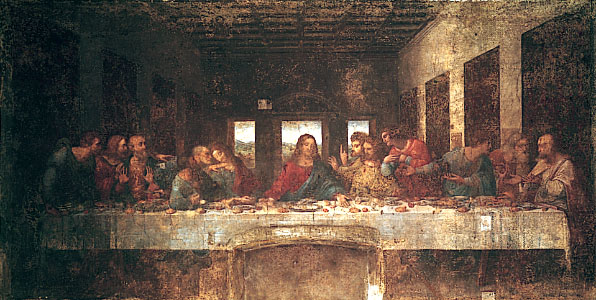Related articles:
This article about the dining arrangements for Jews and Romans gives helpful information to aid our understanding of the account of the Last Supper in John’s Gospel, as well as the account of the woman washing Jesus’ feet, and Jesus washing his disciple’s feet (Jn 12-13).
When we think of the Last Supper, we often imagine Jesus and his disciples sitting around a modern table with upright dining chairs, with their feet underneath the table. This is the scene portrayed by Leonardo Da Vinci in his famous painting. However, Jews and Romans did not sit up at a table, but reclined on couches or cushions around a low table.

A Roman dining room was called a triclinium because it contained three couches, set around a central table. The table was a low block with couches around it on three sides. There would be a single couch in the middle, where the host would sit, and one couch to his left, and one to his right, opposite each other. The side opposite the host would be left open for people to bring food to the table. The couches would be covered by a cushion, or a cushion would be provided for the guest to lean on. The guests approached the table from behind the couches, then reclined on their left side, supporting their head on their left elbow, leaving their right hand free to take the food. A normal Roman triclinium would seat nine people, with three on each couch. For the last supper there were thirteen people present. Either they used larger couches, or laid on cushions on the floor, or were closely squashed together as particularly intimate friends.
Their feet would stretch out behind them, away from the table. This would make it quite easy for Jesus to go round and wash the disciples' feet without them having to move (Jn 13:1-17), and for Mary come in and anoint Jesus’ feet (Jn 12:3).
A man’s head would be in line with the chest of the person reclining to his left, making it easy for that person to lean back and speak to the person on his left without anyone else hearing what is said. In Jn 13, some of the statements made by Jesus were heard by all twelve disciples (v21), while other statements were private (v26).
From the account in Jn 13, it is possible to work out the seating positions of the four people involved in the conversation: Jesus, John, Peter and Judas. At the last supper, Jesus was the host of the meal, so reclined at the head of the table, in the middle of the centre couch. John, the beloved disciple, would be immediately to the right of Jesus, so his head would be level with the chest of Jesus. John would then be able to lean back and whisper to Jesus without the others hearing (v23). The Greek text uses the words, “falling back on the breast of Jesus”.

The place of honour was to the left of the host. This is where Judas was lying. The head of Jesus would be in the breast of Judas, making the seating arrangement an unspoken appeal for friendship and intimacy. Jesus dipped the bread in the common dish, then leant back and gave it to Judas, as the sign to John to identify his betrayer (v26). In the Jewish culture, offering a piece of bread during a meal was a gesture of special affection and friendship, as well as an act of reconciliation. Judas should have responded by dipping a piece of bread in the dish and giving it to Jesus in return. Even at this late time, Jesus offered Judas an alternative to betraying him. Instead, Judas rejected the offer of friendship, and left the room. It was the greatest insult to reject this offer of friendship (v18). The rejection showed that Judas had irreversibly made his mind up to betray Jesus, when Satan entered into him (v27). No wonder Jesus said to Judas, “Do quickly what you are going to do”. The remainder of the disciples would not have heard the conversation and would not have known why Judas had left the room (v28).
Peter must have been sitting on one of the side couches, probably across the table from John, and not next to Jesus, as he made a gesture to John requesting him to ask Jesus to identify the betrayer (13:24).
Bibliography
Barclay, William. The Gospel of John. The Daily Study Bible. Vol 2. St Andrew’s Press, Edinburgh, 1975
Johnston, Harold Whetstone, Private Life of the Romans. Chapter 8: Food and Meals. 1903. www.forumromanun.org/life/johnston_8.html
Morris, Leon, The Gospel According to John. New International Commentary on the New Testament (NICNT). Eerdmans 1995.
Related articles: